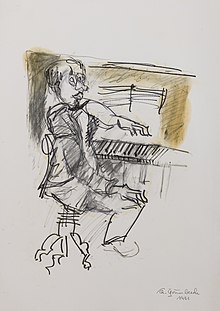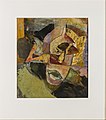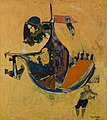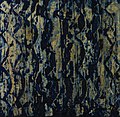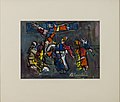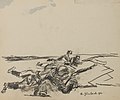Theo Grumbach
Theo Grumbach (born December 18, 1924 in Lieser , Mosel, † January 24, 2000 in Bernkastel-Kues ) was a German painter and draftsman. His post-war modern work is predominantly rooted in Expressionism .
Life
After attending school in his place of birth Lieser and training as a winemaker (1939 to 1940), Grumbach was a soldier on the Eastern Front (1942 to 1944). Then he got into Soviet captivity with mostly forced labor in the mining of Donbass (Ukraine). He returned to his homeland in 1948, seriously ill.
From 1950 to 1953 Grumbach trained as a church musician, until 1975 he worked as an organist , music teacher and choir director, part-time as a winemaker. In 1953 he married Anna Horbert (1925–2006), and the marriage had two sons.
plant
Grumbach began painting as an autodidact in the mid-1950s - inspired by the artists Josef Junk (1919–1994) and Bert Dörr (1920–1981) from neighboring Bernkastel-Kues . At the beginning of the 1960s, everyday scenes as well as mythical and biblical scenes were created, technically implemented as filled, multi-layered oil applications with the finest glazes.
“Theo Grumbach remains the strange natural talent that we know him. The man who lives in the humble rural seclusion of a quiet wine village on the Moselle, far from any kind of art activity, who is solely devoted to organ music and viticulture, paints ... his spun human pictures, reaching to the limits of the abstract, with the technical refinement of experienced academy virtuosos "
At the end of the 1960s, Grumbach shifted his thematic focus to social conditions and his own life experiences, his painting style became more expressive and more striking. Acrylic replaces oil, elements of pop art and neorealism have been incorporated.
Theo Grumbach, […] an expressionist critical of the times and socially critical […] adheres to a hard-contoured, colorful objectivity in his synthetic resin and oil paintings, which are consistently combined with collages. His themes range from 'Metal Veterans' to 'Rhapsody in Blue' and mostly have a tendency towards the fantastic and the surreal "
“His style changed radically. The quiet contemplation and aesthetics of early painting, which were expressed in fine, subtle figuration and terse sign language, were not appropriate to the harsh reality. In his work we encounter grotesque distortions, bizarre chaos and ugliness [...], beyond beautiful appearances and artistic comfort. You speak for an aggressive openness. "
Since 1960 Grumbach was a member of the Society for Fine Arts, Trier , and the European Association of Visual Artists from the Eifel and Ardennes, Prüm , and took part regularly in their annual exhibitions. In 1964 Grumbach made ten black-and-white linocuts, his only prints in addition to his participation in the later portfolio works.
In 1972 he founded the “ Quadriga BKS ” with Bert Dörr, Josef Junk and Johannes Maria Dietz (1930–2015) . The artist group organized the municipal "Galerie 555" in Bernkastel-Kues, published two joint graphic portfolios and carried out a large number of joint exhibitions at home and abroad. Among other things, the Foreign Office initiated a retrospective of the "Quadriga BKS" in 1972 in the German cultural institutes in Ankara and Izmir (Turkey).
At the end of the 1970s, Grumbach took a look at landscapes and architecture: town, village, courtyard, field, vineyard and people. The works of this work phase were more uncomplicated than what had been painted before, yet idiosyncratic and never idyllic. The oil returned to his painting boards, often using mixed techniques.
“[…] Grumbach's colors and his strong application of paint do not necessarily correspond to what we expect from harmonizing images of home. Grumbach's colors are expressive, at times relentless, they lead a strong life of their own. Then suddenly a completely new home opens up. The houses seem to sway, mountains rise threateningly, and even the sweet, familiar grapes seem distant and eerie at night. Even Grumbach's wine bottles have nothing of the carelessness of wine. They are almost threatening in the picture. And in venerable Trier at night the fools dance around the medieval market cross. "
From 1980 to 1995 numerous solo exhibitions were devoted to his work, including in the Bernkastel-Kues Wine Culture Center, in the Catholic Academy in Trier, in the Beda Bitburg house , in “Pro linguis” Hamburg and at Vianden Castle , Luxembourg . From 1981 to 1984 a series of around 100 drawings and sketches was created in which Grumbach directly addressed his experiences of violence without mystery or alienation.
“Grumbach sketches and drawings speak a clear language. You don't need a picture title. They get under your skin. What we see are the ugly sides of being human. Grumbach confronts us with his experiences from the war, the camps, and captivity. We see helpless, defenseless being at the mercy. They are pictures with a drastic quality that is second to none [...] They are emotionally powerful pictures. "
“It can be said that the following also applies to Grumbach's outbreak of memory: the circumstances caused his war memories to be put down on paper. In the context of the social discourse, they stepped out of imprisonment into everyday life in person [...] Possibly the sketches and drawings were the last step in a very personal mourning work, the confrontation with what he called 'his truth'. It was important, not just for the sake of inner peace. "
Theo Grumbach died in January 2000 after a long, serious illness and left behind a diverse and very extensive oeuvre of around 3000 exhibits. A commemorative exhibition was on view in 2014 in the SWR studio in Trier. Paintings by Theo Grumbach can be found in numerous private and public collections, including the State Art Collection of Rhineland-Palatinate, Mainz and the Simeonstift Trier City Museum .
Works
Literature (chronological)
- Eo Plunien (= epl): Mrs. Corinth and the painters from the Moselle . In: The world . April 18, 1980.
- Hans-Joachim Kann: Quadriga BKS . In: Encounters II. Art in Rhineland-Palatinate. A yearbook of the professional association of visual artists Rhineland-Palatinate . Landau 1981, p. 146-156 .
- Maria Blahak: The painting hermit stands in the middle of life. About Theo Grumbach . In: Trierischer Volksfreund . June 19, 1999.
- Eva-Maria Reuther: Theo Grumbach. The painting realist . In: Yearbook of the district of Bernkastel-Wittlich . 2005, ISBN 3-924182-42-6 , pp. 282-285 .
- Mana Binz: Speech at the opening of the exhibition "Landscape painting by Theo Grumbach" . Unpublished Manuscript held in the Bernkastel-Kues Wine Culture Center. Lieser October 1, 2006.
- Hubert Portz: Dance, Soul, Dance! Johannes Maria Dietz, Bert Dörr, Theo Grumbach and Josef Junk. 40 years of Quadriga BKS . Landau 2012, ISBN 978-3-939427-11-7 .
- Hubert Portz: Out and about in the Lord's vineyard. The painter Theo Grumbach. Fragments of a painted life . [With catalog raisonné, status 2012]. Landau 2013, ISBN 978-3-939427-15-5 .
- Hubert Portz: It doesn't work without love! The woman in the artistic work of Josef Junk, Bert Dörr, Johannes Maria Dietz and Theo Grumbach . In: Yearbook of the district of Bernkastel-Wittlich . 2013, ISSN 1863-6004 , p. 286-294 .
- Hubert Portz: Theos Malbude. Post-war modern delivery room. Focus on early works by Theo Grumbach . Catalog for the exhibition in the SWR gallery Trier 8.5-11. July 2014. Hochstadt 2014.
- NN: Theo Grumbach. Pioneer of the modern . In: Grenzecho (Eupen / Belgium) . May 13, 2014.
- Hans-Peter Linz: A humble but effective painter. The illustrated book shows the works of the artist Theo Grumbach, who was born in Lieser . In: Trierischer Volksfreund . June 24, 2014.
- Joseph Groben: Theo Grumbach 1924–2000 . In: The Moselle Valley. Poetry - painting - music. Trier 2015, ISBN 978-3-942429-17-7 , pp. 244-245 .
- Hubert Portz: To hell and back. Late discharge pictures by Theo Grumbach and his way of taking the bite out of war dreams . In: Yearbook of the district of Bernkastel-Wittlich . 2017, ISSN 1863-6004 , p. 205-209 .
- Joseph Groben: Theo Grumbach . In: The silent valley of the Kyll. History - poetry - painting - music . Trier 2018, ISBN 978-3-942429-99-3 , pp. 318-319 .
Film documentaries
Quadriga UCS . Film by Rainer Schirra, Südwestfunk Baden-Baden, 1975 (18 minutes).
Cultural landscape of the Moselle . Film by Rainer Schirra u. Wolf H. Habermehl, Südwestfunk Baden-Baden, 1980 (44 minutes).
Individual evidence
- ^ Carl Gockel (= luc): Exhibition Trier Artists 1962 . Ed .: Trierische Landeszeitung 1962.
- ↑ Eo Plunien (= epl): Mrs. Corinth and the painters of the Moselle . In: The world . April 18, 1980.
- ↑ Hubert Portz: On the way in the Lord's vineyard. The painter Theo Grumbach. Fragments of a painted life . Landau 2013, ISBN 978-3-939427-15-5 , pp. 51 .
- ^ Eva-Maria Reuther: Theo Grumbach. The painting realist . In: Yearbook of the district of Bernkastel-Wittlich . 2005, ISBN 3-924182-42-6 , pp. 285 .
- ↑ Hubert Portz: To hell and back. Late discharge pictures by Theo Grumbach and his way of taking the bite out of war dreams . In: Yearbook of the district of Bernkastel-Wittlich . 2017, ISSN 1863-6004 , p. 209 .
- ↑ Hubert Portz: To hell and back. Late discharge pictures by Theo Grumbach and his way of taking the bite out of war dreams . In: Yearbook of the district of Bernkastel-Wittlich . 2017, ISSN 1863-6004 , p. 208 .
| personal data | |
|---|---|
| SURNAME | Grumbach, Theo |
| BRIEF DESCRIPTION | German painter and draftsman |
| DATE OF BIRTH | December 18, 1924 |
| PLACE OF BIRTH | Lieser , Moselle |
| DATE OF DEATH | January 24, 2000 |
| Place of death | Bernkastel-Kues |

